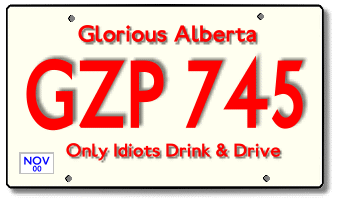 This principle states that "If there are r ways to do one thing, and s ways to do another, and t ways to do a third thing, and so on ..., then the number of ways of doing all those things at once is r x s x t x ..." Let's look at an actual example and try to make sense of this rule. How about a license plate ...  How many different license plates are there altogether? Look at what's used to make a plate:
The total number of ways to fill the six spaces on a licence plate is 26 x 26 x 26 x 10 x 10 x 10 which equals 17,576,000 How could the province increase the total number of possible license plates? One way would be to make the plates with four letters and two numbers. Then the total number of plates would be: In actual practice, there are often restrictions on which letters and numbers can actually be used. Let's go back to the original plate, where there were three letters and three numbers. Suppose we insist that the letter 'O' not be used at all, since it could be mistaken for a zero. Furthermore, no license plates can have a three-digit number greater than 799. Finally, we won't allow any license plate to start with the letter 'I'. How many different plates will there be? There are only 24 choices for the first letter, since neither 'O' nor 'I' may be used. There are only 25 choices for each of the second and third letters, since 'O' can't be used. There are only 8 choices for the first number, since neither '8' nor '9' can be used. There are a full 10 choices for each of the last two numbers. The total number of ways to fill the six spaces on a licence plate is now 24 x 25 x 25 x 8 x 10 x 10 which equals 12,000,000 Get the idea? O.K., here's one for you to try. A four digit code is to be made, using numbers from 0 through 9 (ten choices). But the four-digit code cannot be a number greater than 6999, can't start with zero, and it must be an odd number. How many different codes are there? Scroll down to check your result. First digit can't use 7, 8, 9, or 0 .............. 6 choices Second digit no restrictions ................... 10 choices Third digit no restrictions ....................... 10 choices Fourth digit can only be 1, 3, 5, 7, 9 ........ 5 choices Total no. of codes is 6 x 10 x 10 x 5 = 3000 |